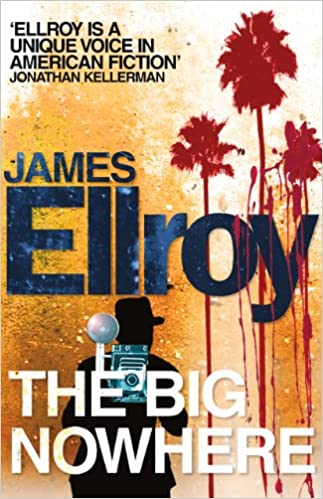OK I GIVE UP
The Big Nowhere

Ellroy’s novels are based on character power; living people who jump at you with their physical characteristics, possessing histories and reasons for the crazy things they do. Ellroy then puts these people into high-strung action in LA, makes them drive from one distant part of the city to another, take part in shady dealings, and engage in the corrupt businesses that pervaded the LA of the 50s and 60s. Although the stories are so far out, the characters carry the weight, and make the stories believable. When reading Ellroy novels, instead of following a story line, one is following realistic characters at work, looking them over the shoulder while they are beating people up, shooting at each other, or collecting evidence.
The main characters in The Big Nowhere are a young ex-car-thief detective named Danny Upshaw who became a cop because he witnessed a woman getting murdered, a former Nazi-interrogator detective Named Mal Considine, and a brutal and corrupt ex-policeman named Turner Buzz Meeks. The story revolves around two main strands. One is a grand jury investigation to follow up on the HUAC and nail even more Communist Party members in Hollywood, an effort funded by the Studio bosses and gangsters. This investigation is taking place at the same time with vicious murders of men known to be part of the homosexual circles of LA. The secondary characters –which aren’t secondary at all concerning their role in the action– are too numerous to count, and as in Black Dahlia, turn up as the main figures of the background events, forcing one to reevaluate the initial assesment one made when they were introduced.
The character focused on changes as the story moves from one stage to the next. The early chapters mostly tell the story of how Upshaw collects evidence to hunt the murderer who mutilates his victims with wolverine teeth dentures, and cuts them up with zoot sticks (a nice segue from the previous novel Black Dahlia, which began with the zoot suit riots). As the communist hunt takes pace, Mal Considine moves more into focus, along with his past in Germany after the war and his struggle to take custody of his adopted son who he brought with him from Prague. The later chapters belong to Buzz Meeks, and his effort to free himself from the mess he got into by bedding the girlfriend of Micky Cohen, one of the most powerful mafia bosses of the time. Upshaw, Considine and Meeks make deals and promises for the particular reasons that drive them, the dynamics that pushes the story. Among these characters, all are very believable except for Considine, who is a bit too schematic at times, and is not clearly grounded.
One aspect of the book that would make it difficult to read for some people is the continuous use of derogatory words for racial and sexual minorities. Members of the police force never use the politically correct terms we are used to now, and that they are less restrained in their use of brute force when dealing with homosexuals, latinos and blacks is easy to infer (I don’t think the situation has changed that much, but at least we’re more conscious of it now). Some people might find this offending, but the fact of the matter is that this is a past we can’t run away from, and artificially cleaning the past would lead to just this, a clean past, which would be devoid of warnings and the extremely ugly face of racial and homophobic hate that leads to the great crimes to go unnoticed and unpunished.
The Big Nowhere is one of the darkest and most harrowing novels I have read, but it’s also one of the most tense and absorbing. I know which author I will be reaching for when I’m in the mood for some LA action in the Berlin U-Bahn.